La mia attenzione è caduta su Charlie Colmer mentre cercavo immagini che mi aiutassero a migliorare la mia comprensione di ciò che è una foto bressoniana. Nel suo reportage "Multicultural Britain" ho trovato più di quanto avrei potuto ottimisticamente aspettarmi.
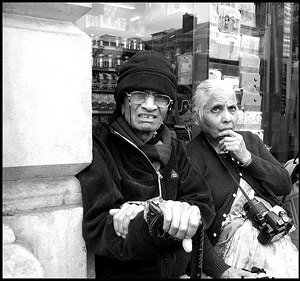
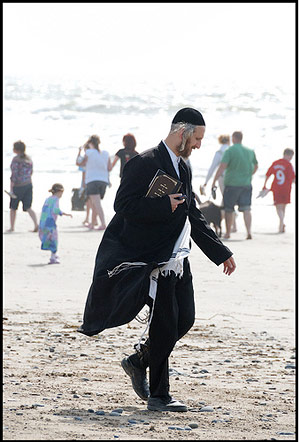

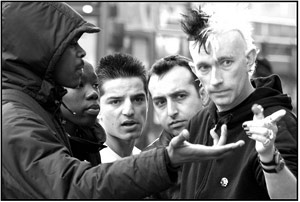
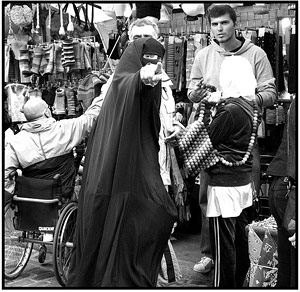
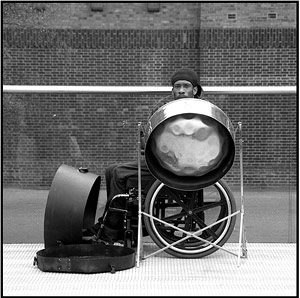
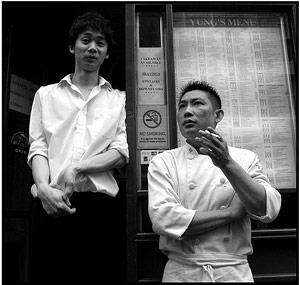
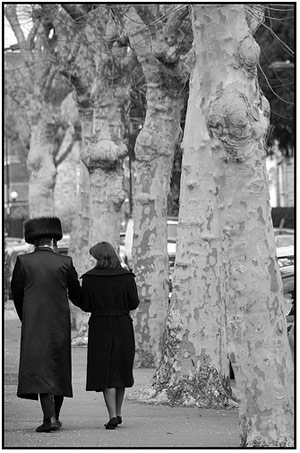
E tuttavia questo non spiega ancora perché valga la pena di studiare questo reportage, perché un qualsiasi catalogo di facce, abbigliamento e simboli rappresentativi di una diversa cultura avrebbe potuto ricadere in questo schema. L'elemento distintivo è, naturalmente, il contenuto delle foto: piccoli frammenti di vita giornaliera colti al massimo dell'intensità espressiva in più "istanti decisivi" di quanti ne apparirebbero a prima vista.
Prendiamo ad esempio le Figg. 1 e 2. Entrambe ritraggono una coppia che si concede un attimo di riposo durante quella che sembra essere una passeggiata in città. Le storie che raccontano non potrebbero essere più diverse, nella prima il linguaggio del corpo ci comunica un senso di tranquilla contentezza, nella seconda si percepiscono disagio ed inquietudine, sottolineati dal modo certamente non ortodosso di portare la fotocamera. Ma né l'una né l'altra sensazione avrebbe potuto essere comunicata senza l'equilibrio nell'atteggiamento delle due persone nella prima foto e senza lo sguardo fisso ed assente nella seconda. Un istante prima o dopo questi potenti segnali avrebbero potuto non esserci, e se questi non sono istanti decisivi non saprei come altro chiamarli.

Fig.10
La Fig. 10 (vedi sopra) è l'eccezione alla quale ho fatto riferimento più sopra, perché rivela un'intenzione dell'autore. Non ha importanza se ha dovuto attendere a lungo prima che la persona giusta passasse davanti alla vetrina o se ha riconosciuto un rapporto tra il primo ed il secondo piano in una frazione di secondo, l'associazione tra la vetrina e la donna era un prodotto della sua mente, ed è questo che la foto avrebbe comunicato se non fosse accaduto qualcosa di particolare: la donna velata ha distolto lo sguardo da qualcosa che nella sua cultura sarebbe fonte di vergogna. Si è così stabilito un legame dominante tra la donna e la rappresentazione della nudità, legame che va oltre il semplice accostamento di due elementi contrastanti. Un così sottile dettaglio può trasformare una buona foto in una foto eccellente.
La Fig. 3 è una delle poche di una serie prevalentemente in bn nella quale Charlie fa uso del colore perché il soggetto lo esige, così l'abito nero in primo piano si stacca contro i colori sbiaditi dello sfondo.
Da notare anche che il progetto non è ancora concluso e che dal momento in cui abbiamo preparato questa recensione la serie si è arricchita di altre foto.
Nel complesso un piacere per l'occhio e qualcosa da imparare.
Romano Sansone
© 08/2010
Riproduzione Riservata
English version.
I came across Charlie Colmer's work when looking for photographs that would help me consolidating my understanding of the bressonian photography. With his reportage "Multicultural Britain" I got more than I was bargaining for.
With the author's permission we have chosen 10 photographs for publication in our Portfolios section, but looking at all of them will be time well spent. As one goes through the series and the individual images melt into a unitary view one cannot help noticing that the author does not attempt to convey his own views about such a complex and often controversial theme as multiculturalism, but he is "just" out to document its existence in its so many facets. This is in the best bressonian tradition, and, with one notable exception, this principle is respected in every single photograph: the author shows us what he saw, he doesn't ask us to read his thoughts through some clever combination of the element of the scene.
Yet this does not explain what makes this reportage worth looking at, as any catalogue of faces, dresses and symbols representative of different cultures could have been made to fit the same frame. The distinctive character, of course, is the content of the photographs: tiny fragments of day to day life, caught at the peak of expressive intensity and accounting for more " decisive moments" than one would think at first sight.
Take for instance Fig. 1 and 2: both portray a couple taking a rest during what appears to be a leisurely walk in town. The stories they tell could not be more different, in the first one the body language speaks of a quiet contentedness, the second tells about disconfort and uneasiness, underlined by the careless way the woman carries the camera. But neither feeling could be effectively communicated without the balanced postures of the first one or the absent look of the people in the second. One instant earlier or later these powerful signals might not have been there, and if these were not decisive moments I wouldn't know what they were.
Fig. 10 is the odd picture I was referring to as it reveals an intention of the author. It is not relevant whether he had been waiting for the right person to walk by or whether he established an association between foreground and background in a fraction of a second, the link between the window and the woman was in his mind, and the picture would have communicated just that if something special had not happened: the veiled woman turned her head away from what in her own culture would appear as shameful, establishing a dominant link between herself and the naked representations of the human body. Such a subtle detail can turn a good picture into an excellent one. While most of his production is in B&W Charlie makes some use of colour when the subject calls for it, like in Fig. 3 where the black dress in the foreground stands out against the pale color of the background.
All in all a pleasure to look at and something to learn from.
Romano Sansone © 06/2010
All Rights Reserved